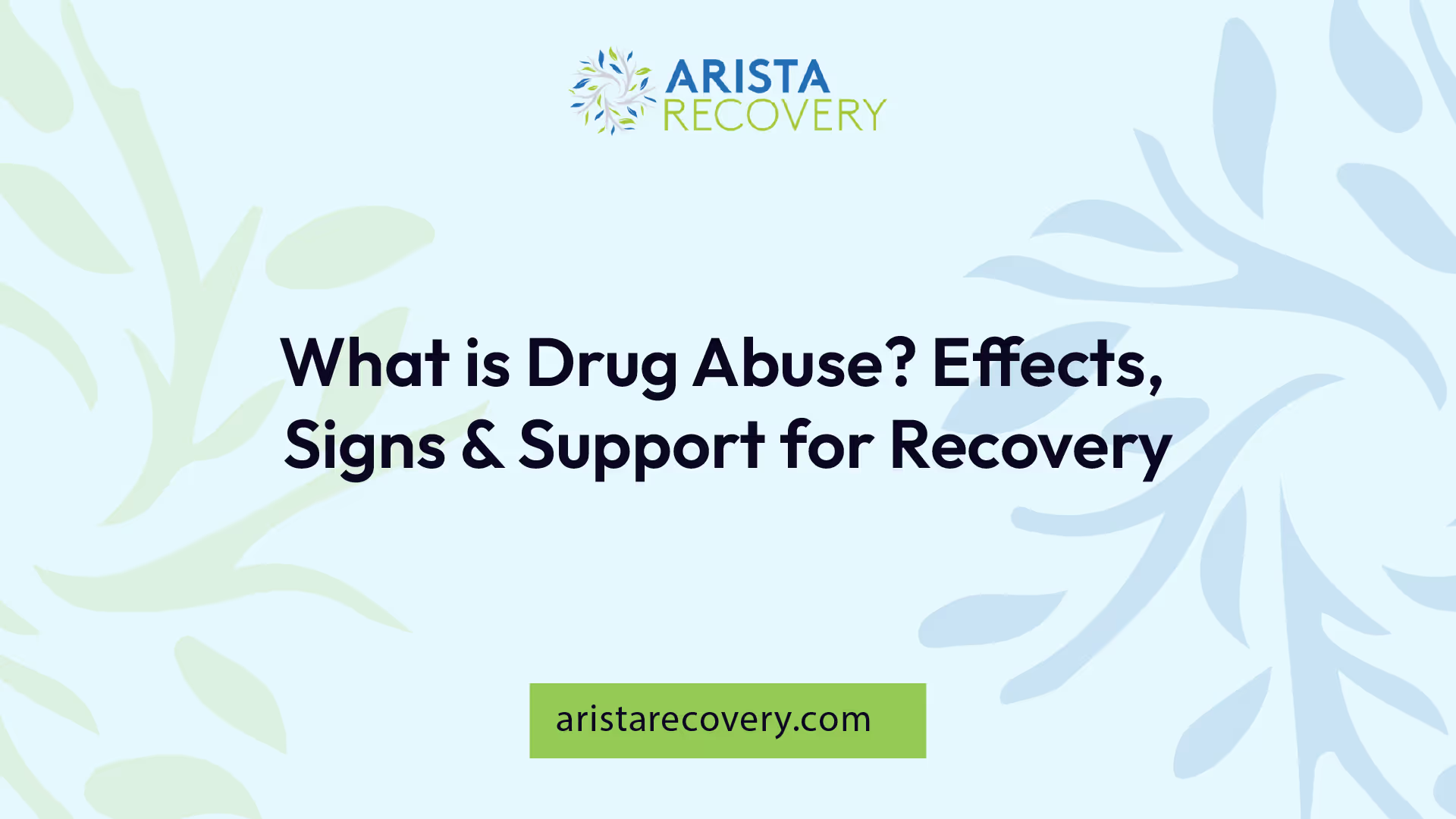What is Drug Abuse? Effects, Signs & Support for Recovery

Understanding Drug Abuse
Definition of Drug Abuse
Drug abuse, also known as substance abuse, involves the use of specific chemicals to induce pleasurable effects on the brain. It encompasses both illegal drugs and the misuse of prescription medications. Presently, there are over 190 million drug users globally, with rising rates of substance abuse particularly among individuals under the age of 30.

Effects of Drug Abuse
Substance addiction, formally recognized as a substance use disorder, profoundly influences a person's brain and behavior. This condition leads to an inability to control the consumption of legal or illegal drugs, such as alcohol, marijuana, and nicotine. Individuals may continue to utilize these substances despite experiencing harmful consequences.
The adverse effects of drug abuse can be extensive and include both physical and psychological consequences. Here is a breakdown of the potential outcomes:
Type of EffectSpecific ConsequencesPhysical Health IssuesHeart disease, lung cancer, kidney failure, liver damage. Some may be permanent, but many can improve with treatment.Relationship ProblemsBreakdown of familial and social connections.Legal IssuesTrouble with law enforcement due to illegal activities.Financial ProblemsIncreased expenses due to addiction and potential job loss.Overall HealthPoor physical and mental well-being due to neglect.
Drugs can drastically overstimulate the brain's reward system by flooding it with dopamine, making individuals more likely to repeat their drug use. Over time, continuous substance abuse can result in lasting, and in some cases, irreversible changes to the brain.
Short-Term Effects
Drug abuse can have immediate and noticeable effects on both physical and psychological well-being. It is essential to understand these short-term effects to fully grasp the implications of substance misuse.
Physical Effects
Short-term physical effects of drug abuse can vary depending on the substance used. Common physical symptoms may include:
Physical SymptomsDescriptionDilated PupilsPupils appear larger than normal, a response to certain stimulants.Increased Heart RateThe heart beats faster than usual, often resulting from stimulants.Increased Blood PressureHigher blood pressure can occur, increasing the risk of cardiovascular issues.Reduced AppetiteMany drugs suppress the desire to eat, which can lead to nutritional deficiencies.WakefulnessCertain substances can cause heightened alertness, often seen with stimulants.
These effects can lead to further complications down the line if substance use continues.
Psychological Effects
The psychological impact of drug use can be immediately significant, affecting mood, perception, and behavior. Common psychological effects include:
Psychological SymptomsDescriptionEuphoriaA heightened sense of joy or excitement experienced with certain drugs.AnxietyIncreased feelings of nervousness or tension, which can be exacerbated by stimulants.ParanoiaFeelings of mistrust and irrational fears may arise, especially with certain substances.HallucinationsSome drugs can cause perceived sensations that don’t exist, affecting reality perception.Impaired JudgmentDecision-making abilities can be severely hindered, leading to risky behaviors.
These psychological effects can contribute to long-term mental health issues if not addressed. Understanding these immediate impacts is critical in addressing the broader question of "what is drug abuse?" and its consequences on human behavior and health.
Long-Term Consequences
The long-term consequences of drug abuse can significantly impact an individual's health and well-being. These can manifest in several forms, including chronic health risks and mental health impacts.
Chronic Health Risks
Long-term substance abuse is linked to various chronic conditions that can severely affect physical health. The following table summarizes some of the common chronic health risks associated with different types of drug abuse:
Type of DrugChronic Health RisksOpioidsLiver disease, heart diseaseMethamphetaminesSevere dental problems, skin sores, weight loss (American Addiction Centers)MarijuanaCannabinoid hyperemesis syndrome: cyclic vomiting, dehydration (American Addiction Centers)
In addition to these specific risks, drug abuse may result in general chronic health conditions such as lung disease and liver damage [4].
Mental Health Impacts
Mental health is heavily influenced by long-term drug abuse, leading to a range of psychological effects and disorders. Some of the most significant implications include:
These mental health challenges can complicate recovery efforts, making it harder for individuals to quit and stay sober. Understanding these long-term consequences is crucial in educating oneself about drug abuse and its implications.
Types of Drugs Abused
Understanding the various types of drugs that are frequently abused is essential for addressing the issue of addiction. This section covers three major categories: opioids, stimulants, and cannabis.
Opioids
Opioids are a class of drugs that include both prescription painkillers and illegal substances like heroin. These drugs are known for their high potential for addiction. Opioid painkillers can cause addiction more quickly than many other substances, leading to an increased need for larger doses to achieve the desired effect. Chronic opioid misuse is associated with several adverse effects on the organs and systems within the body, posing significant health risks for users.
Opioid TypeCommon ExamplesUsers Worldwide (Approx.)Prescription PainkillersOxycodone, Hydrocodone8 millionHeroinIllegal Opioid8 million
Stimulants
Stimulants are drugs that increase alertness, attention, and energy. Commonly misused stimulants include amphetamines (like Adderall and Dextroamphetamine) and methylphenidate (such as Concerta and Ritalin). Misuse of these substances can lead to addiction and dangerous side effects, such as irregular heartbeat and increased body temperature. Combining stimulants with decongestants can result in dangerously high blood pressure or arrhythmias.
Stimulant TypeCommon ExamplesUsers Worldwide (Approx.)AmphetaminesAdderall, Dextroamphetamine30 millionCocaineCocaine Powder, Crack Cocaine13 million
Cannabis
Cannabis, which includes marijuana and hashish, is the most widely abused drug globally. Around 141 million people consume cannabis worldwide. Although it is often perceived as a less harmful substance, chronic use can lead to significant health issues such as a rare condition known as cannabinoid hyperemesis syndrome, characterized by severe nausea and vomiting.
Cannabis TypeCommon FormsUsers Worldwide (Approx.)MarijuanaDried flowers141 millionHashishConcentrated resin141 million
Identifying these substances and their prevalence is important for understanding addiction and the subsequent treatment and prevention efforts needed for recovery.
Signs of Drug Addiction
Identifying the signs of drug addiction is vital in understanding what drug abuse entails. Drug addiction, often referred to as substance use disorder, significantly impacts an individual's behavior and choices, leading to compulsive usage despite harmful repercussions [2].
Behaviors to Watch For
There are several behaviors that may indicate an individual is struggling with drug addiction. Recognizing these signs can facilitate earlier intervention and support.
BehaviorDescriptionIncreased SecrecyThe individual may become more withdrawn and guarded, avoiding discussions about their activities or whereabouts.Neglecting ResponsibilitiesA noticeable decline in performance at work, school, or personal relationships may occur as substance use takes priority.Changes in Social CirclesThe person may start to associate with a different group of friends, often those who share the same substance use habits.Financial ProblemsFrequent requests for money or signs of financial instability may indicate spending on drugs.Risky BehaviorEngaging in dangerous activities or legal issues related to drug use can be a significant warning sign.
Individuals who abuse drugs might use various substances, such as alcohol, cocaine, prescription pain pills, or others, despite severe substance-related issues.
Common Denial Patterns
Denial is a common feature when it comes to drug addiction, making it challenging to recognize and address the issue. Individuals may exhibit various denial patterns that prevent them from acknowledging their addiction.
Denial PatternDescriptionMinimizationThe individual may downplay the impact of their substance use, insisting that it is not a problem.Blaming OthersThey might attribute their substance use to stressors in their life or blame other people for their addiction.Justifying UseThe person may provide excuses for their drug use, claiming that it helps them cope with specific situations or emotions.Comparing with OthersThey may argue that their use is less severe than others', suggesting that their habits do not merit concern.
Understanding these denial patterns can help friends and family recognize when intervention is required. Identifying drug addiction can be complex, but the first step toward help lies in acknowledging the problem [7].
Prevention and Intervention
Addressing drug abuse involves recognizing substance use disorders and seeking appropriate support and treatment. Understanding these aspects is essential for effectively confronting addiction.
Recognizing Substance Use Disorders
Substance use disorders occur when an individual continues to use substances like alcohol, cocaine, prescription pain pills, or other drugs, despite facing significant problems related to their use. This often leads to prioritization of the substance over familial, relational, and career responsibilities, even when those responsibilities are severely impacted.
Identifying signs of drug addiction can be difficult due to the tendency for individuals to deny their substance use issues. Being aware of the following indicators can aid in recognizing when intervention might be necessary:
Signs of Drug AddictionDescriptionChange in BehaviorSudden shifts in mood or personality, secrecy, or withdrawal from family and friends.Neglecting ResponsibilitiesFailure to fulfill obligations at work, school, or home.Physical Health IssuesObservable changes such as weight loss, poor hygiene, or health complications.Risky SituationsEngaging in dangerous activities while under the influence.
Acknowledging these signs is critical, as drug addiction can have devastating effects on an individual’s life. Substance use disorder impacts the brain's wiring and behavior, leading to an inability to control the use of both legal and illegal substances.
Seeking Support and Treatment
After recognizing the signs of substance use disorder, the next step is to seek help. This may involve professional treatment, support groups, or counseling. Various options exist for treating addiction, which can include:
Treatment OptionsDescriptionDetoxificationThe process of clearing drugs from the body and managing withdrawal symptoms.Behavioral TherapyHelps individuals change their thinking patterns and behaviors related to substance use.Support GroupsCommunity support from others who understand addiction, such as Alcoholics Anonymous (AA) or Narcotics Anonymous (NA).MedicationPrescribed medications may assist with managing withdrawal symptoms and reducing cravings.
Engaging in treatment is paramount, as drug addiction can lead to physical health problems like liver damage, heart disease, and mental health issues such as depression and anxiety. By seeking support and intervention, individuals can begin their journey toward recovery and reclaim their lives from the grasp of addiction.
References
[2]:
[3]:
[4]:
[5]:
[6]:
[7]:
You’re not alone in this.
When mental health challenges and addiction intersect, it can feel isolating. At Arista, we offer compassionate, evidence-based, and trauma-informed care to help you heal, grow, and move forward.
You’re not alone in this.
When mental health challenges and addiction intersect, it can feel isolating. At Arista, we offer compassionate, evidence-based, and trauma-informed care to help you heal, grow, and move forward.
Support that moves with you.
You’ve taken a brave first step. At Arista Recovery, we’re here to help you continue with best-in-class care designed for long-term healing and support.
.webp)






